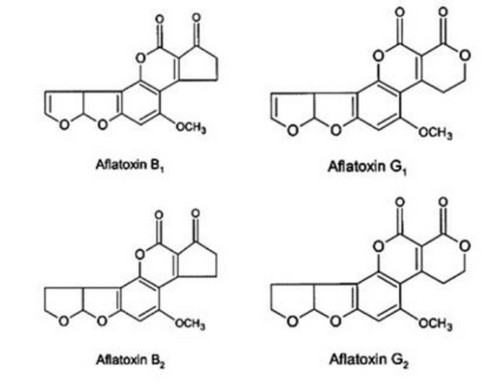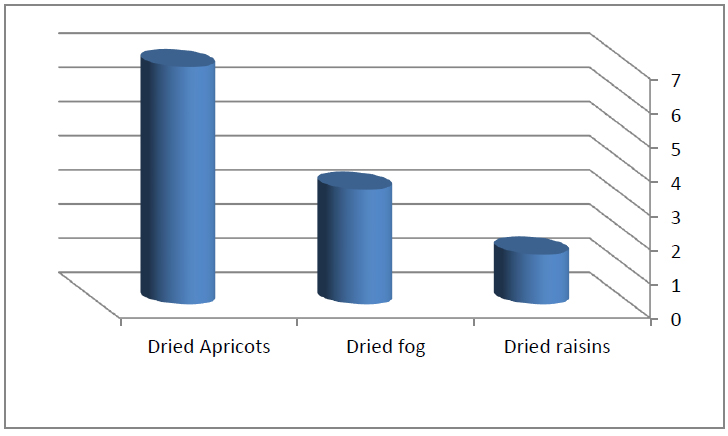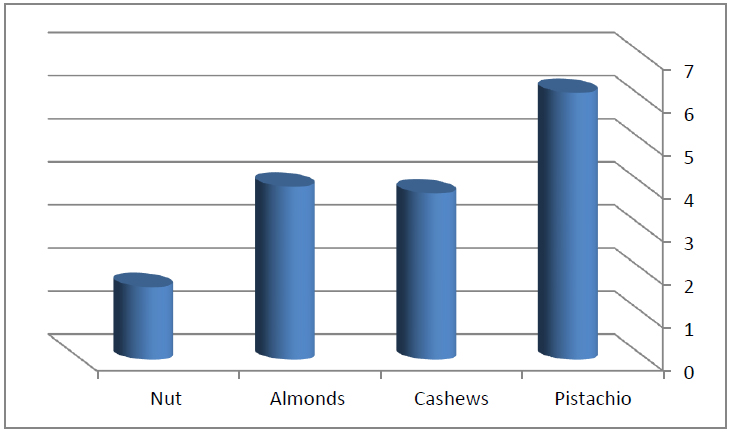2021.06.03.23
Files > Volume 6 > Vol 6 No 3 2021
INVESTIGATION / RESEARCH
Investigation about contamination of some food items in local markets, Mosul, Iraq.
Ammar Nafea Alnema1, Mazin Nazar Fadhel 2
Available from: http://dx.doi.org/10.21931/RB/2021.06.03.23
Results of enzyme-linked immunoassay (ELISA), which was conducted on 58 samples of dried fruits and nuts available in the local market in Mosul city that there were samples that are contaminated with aflatoxins with rates higher than the tolerated level permitted by the European Union (4 parts per billion) in the human-consumed foodstuff products as the percentages were 40%, 40, 70% and 10% for almond, cashew, pistachio, and walnut respectively, which are beyond the permitted level. At the same time, the percentages were 66% and 10% for dried apricot and figs, respectively, and more than the permitted level. The average quantity of aflatoxins in the nuts samples was (1.6, 3.8. 4.1 and 6.1 ppb) for walnut, cashew, almond, and pistachio, respectively, while in the dried fruits (3.3, 1.4, and 6.9 ppb) for raisin, figs, and apricot respectively.
Keywords: aflatoxin pollution, (ELISA), Mycotoxins.
INTRODUCTION
Aflatoxins are secondary metabolites with relatively low molecular weights produced by genus Aspergillus that affect the human-consumed foodstuff and animal fodders1. The United Nations Foods and Agriculture Organization (FAO) estimated that about 25% of foodstuff and fodders worldwide are polluted with aflatoxins2.
The foodstuff that is more subject to aflatoxins is cereals, spices, rice, corn, nuts, and dried fruits3. The term was used for the first time in 1952 when animal diseases were studied 4.
In general, toxins affect the foods in various stages: transport, storage, or affecting the various crops in the growth stage before the harvest. The effect of these poisons is associated with the quantities consumed, as having them for long periods with small quantities in foods and fodder causes chronic diseases to humans and animals, while having large quantities for short periods leads to acute cases and might result in death in most of the cases5.
Aflatoxins stand for a set of metabolites, which are severely poisonous and produced by certain types of Aspergillus species, including Aspergillus flavus, Aspergillus parasitic us, and Aspergillus nomius during their growth on foods and fodders 6.
The most critical main aflatoxins types are (G2, G1, B2, and B1). Aspergillus flavus produces type B only, whereas the other two (Aspergillus parasiticus and Aspergillus nomius) produce G and B. The two letters "B" and "G" refer to the two colors, blue and green, produced when subjected to the ultraviolet rays on the TLC plates, while the numbers 1 and 2 refer to the main ad the secondary compounds, respectively 7.

Figure 1. Chemical structure of aflatoxin B (AFB1 and AFB2), aflatoxin G (AFG1 and AFG2)8.
Aflatoxin B1 is considered the most poisonous, and it was identified as the most carcinogenic chemical that occurs naturally in the liver.
The International Agency classified AFB1 for Cancer Researches as a first-class carcinogen, and several epidemics studied demonstrated a relationship between aflatoxins and stomach, intestine, and liver tumors in Africa, the Philippines, and China9. Therefore, regulations were adopted by many countries to control the concentrations of Aflatoxin in foods as the concentration of Aflatoxins was restricted to the highest concentration in nuts and dried fruits to be (4 µg/kg)10.
The primary purpose of this work is to test the level of AFs in samples of dried fruits and nuts which are available in the local markets in Mosul city, Iraq, that are consumed in huge quantities and on a wide range.
MATERIALS AND METHODS
Sampling
Samples were collected in January 2021and they were 58 samples (n=58). These samples included dried fruits and nuts Included: (6 samples of dried grapes, 6 samples of dried apricot, 6 samples of dried figs, 10 samples of walnut, 10 samples of almonds, 10 samples of cashews, and 10 samples of Allepo pistachios), which were all bought from the local market in Mosul city. Each sample was ground to a volume of 250 grams, put in plastic bags, taken to the laboratory, and analyzed immediately in search of AFs11.
Chemical and reagents
The number of Aflatoxins in the samples was measured according to Ela science American company using Enzyme (ELISA).
Reagents: Methanol, N-hexane, were obtained from Merck (Darmstadt, Germany), Methanol (V): Deionized water (V) =7: 3
The extraction procedure
Sample uniformity using an electrical blender. A quantity of 2 grams of the homogeneous sample was weighted, put in the 50 ml-capacity centrifuge tube. Then 8 ml of N-hexane and 10 ml of methanol 70% and they are shacked well for 5 minutes and then they are put in the centrifuge at 4000 round per minute for 10 minutes at the room temperature. The upper liquid is removed, and 0.5 ml of the lower liquid is taken to another centrifuge tube. After that, 0.5 ml of deionized water is added and thoroughly mixed. A quantity of 50 µl is taken for analysis and detection. The test is conducted. All the reagents and samples are prepared at room temperature before using them.
Sample's numbering: The samples are numbered in order, and records of standard well and wells samples are kept.
Sample's addition: a volume of 50 microliters is added to each well, and then 50 µl of conjugated HRP is added to each well, and then 50 µl of antibody action solution is added. After that, the plate is sealed with a plate stopper; it is shacked for 5 seconds to get a good mixture and put in the incubator for 30 minutes at 25 Cº.
Wash, examine carefully, and remove the liquid. Immediately add 300 µl of wash buffer to each well, and the process is repeated 5 times with intervals of 30 seconds. The plate is reversed and fixed on a thick, clean, and absorbent paper (if there were bubbles in the wells, clean tips are used to pierce them).
Color development: 50 µl of substrate reagent A is added to each well, and then 50 µl of the substrate reagent B is added and shake gently until a good mixture is obtained and after that, it is incubated for 15 minutes in the slight shade (the time of the reaction can be extended according to the fundamental change in the color). Suspension of the reaction: 50 µl of the suspension solution is added to each well and shaken gently for good mixing.
OD measurement: Determining the optical density (OD value) for each well at 450 nanometers (the standard wavelength is 630 nanometers) using the microplate reader. This step should be completed within 10 minutes after the suspension of the reaction12.
RESULTS AND DISCUSSION
The Aflatoxins quantitative measurement of dried fruit and nuts samples in the local markets in Mosul city showed that they are highly polluted with these poisons, and several samples were polluted at a rate higher than the accepted limit stipulated by the European Union.
Dried fruits
Results of the test, as shown by table (1), that apricot contains the least quantity of Aflatoxin (1.948 per billion) and the highest was (12.295 per billion) due to the long period of storage of the samples and this is because the low demand on it during January and this conforms with what was found by 13. in their study of 20 samples of dried apricot, as they found that 4 sample was highly polluted.

Table 1. Results of the occurrence of AFs in the analyzed dried fruit samples
The Results Shown that figs dried is polluted with the Aflatoxin with the highest value (13.694 per billion) and the lowest value (0.296 per billion), and the average quantity of Aflatoxin (3.354 per billion) as shown in figure 2.

Figure 2. Average concentrations of AFLA in dried fruit samples.
As for raisin, the analysis results showed that the samples included concentrations of Aflatoxin at the accepted range as the highest pollution with Aflatoxin was (3.096 per billion), while the lowest was (0.000 per billion). The average quantity of Aflatoxin was (1.456 per billion).
Nuts
The analysis showed that several samples of nuts exceeded the acceptable limit, as shown in Table 2. These results demonstrated that the pollution was (40%) in the almonds samples and the pollution levels between (1.838 to 8.726 per billion) and the average quantities of Aflatoxin was (4.017 per billion), as displayed in figure 3.

Table 2. Results of the occurrence of AFs in the analyzed nuts samples

Figure 3. Average AFLA Concentrations in Nuts Samples.
Results of the walnuts test also revealed that one of the samples exceeded the tolerated limit of the European Union (4 per billion) for the total AF in the foodstuff and its concentration was (11.529 per billion) due to the lousy storage, high humidity, and the long period of storage and the average quantity in the samples was (1.687 per billion).
AFL concentrations in cashew samples ranged between (2.701 per billion), and this value lies within the tolerated limit. The average quantities in the sample were (3.857 per billion).
For the AFL concentrations in measured pistachio samples, the highest values were (9.761 per billion) and the most negligible value was (1.814 per billion), and the average quantity of Aflatoxin was (6.195 per billion) as shown in table 2 and figure 3.
DISCUSSION
Through the qualitative and quantitative detection of Aflatoxins in the samples of the nuts and the dried fruits used in the study that used the ELISA technique, results showed that some samples were polluted with Aflatoxins.11,12found that the pollution of nuts with Aflatoxin with a percentage of 43% with concentrations that range between 0.58-15.2 µl per billion. The reason behind that was inadequate storage, extended storage, and humidity, which led to increased Aflatoxins in the samples.
The current research recommends that several actions should be taken to limit the occurrence of mycotoxins in foods. First of all, storing the foods in good conditions and also conducting coordinated studies with the Colleges of Medicine and other relevant specializations to diagnose the fungi and the diseases they cause in an attempt to limit them and also symposiums should be held to raise the awareness of the society about the risks of these poisons and the ways to avoid them.
CONCLUSION
It is concluded that Aflatoxins highly pollute the samples of nuts and dried fruits in question, and this implies a high risk of cancers incidence, especially liver cancer.
Acknowledgments
We, the authors, bear witness that what has been mentioned in this research in terms of results and everything is our own, and we bear responsibility in the event of any problem.
Author's conflict
We researchers acknowledge that there is no conflict with our interests.
REFERENCES
1- Calderari, T.O., Iamanaka, B.T., Frisvad, J.C., Pitt, J.I., Sartori, D., Pereira, J.L., Fungaro, M.H.P., et al.,. The biodiversity of Aspergillus section Flavi in Brazil nuts: from rainforest to consumer. Int. J. Food Microbiol.2013; 160 (3), 267–272.
2- Park ,O.L.H. Niapau , E.Boutrif. Minimizing risks posed by mycotoxins utilizing the HACCP concept .2009; 17 November, Available from .
3- Smith, M. C., Madec, S., Coton, E., & Hymery, N. Natural co-occurrence of mycotoxins in foods and feeds and their in vitro combined toxicological effects. Toxins,2016; 8(4), 94
4- Dhanasekaran, D., Shanmugapriya, S., Thajuddin, N., & Panneerselvam, A.Aflatoxins and aflatoxicosis in human and animals. Aflatoxins-Biochemistry and Molecular Biology,2011; 221-254 .
5- Chukwuka,O.K. ; Okoli ,I.C. ; Opara,M. N. ; Ogbuewu ,I.P . and Iheshiulor, O.O.M.The growing proplems of mycotoxin in animal feed industry .Asian.J.Poultry.Sci.,2010; 4:122-134
6- Kumar, P., Mahato, D. K., Kamle, M., Mohanta, T. K., & Kang, S. G.Aflatoxins: a global concern for food safety, human health and their management. Frontiers in microbiology,2017; 7, 2170.
7- A Saadullah, A., & K Abdullah, S. Detection of Aspergillus species in dried fruits collected from Duhok market and study their aflatoxiginic properties. Rafidain journal of science,2014; 25(1), 12-18.
8- Zain, M. E. Impact of mycotoxins on humans and animals. Journal of Saudi chemical society,2011; 15(2), 129-144.
9- Marchese, S., Polo, A., Ariano, A., Velotto, S., Costantini, S., & Severino, L. Aflatoxin B1 and M1: Biological properties and their involvement in cancer development. Toxins, 2018; 10(6), 214.
10- Commission Regulation (EC) n.1881/2006 of 19 December 2006 Setting Maximum Levels for Certain Contaminants in Foodstuffs. Official Journal of the European Union,2006; 364, 5-24.
11- Commission, E. Commission Regulation (EC) No 401/2006 of 23 February 2006 laying down the methods of sampling and analysis for the official control of the levels of mycotoxins in foodstuffs. Off. J. Eur. Union.2006; 12–34.
12- Commission, E. Commission Regulation (EC) No 165/2010 of 26 February 2010 amending Regulation (EC) No 1881/2006 setting maximum levels for certain contaminants in foodstuffs as regards aflatoxins. Off. J. Eur. Union.2010; 8–12 .
13- Luttfullah, G., & Hussain, A. Studies on contamination level of aflatoxins in some dried fruits and nuts of Pakistan. Food Control,2011; 22(3-4), 426-429 .
Received: 11 May 2021
Accepted: 25 June 2021
Ammar Nafea Alnema1, Mazin Nazar Fadhel 2
Department of Environmental Sciences, College of Environmental Sciences and Technology, Mosul University, Iraq
*Author for correspondence: E-mail: [email protected]
ORCID 0000-0002-9775-249X
